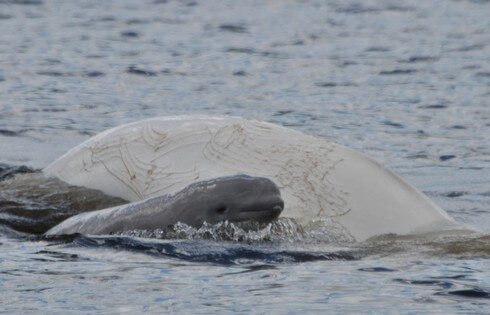Our team began to see the first calves of the year several weeks ago already, but in the past two weeks, we have been encountering them in almost every herd, and even up to five in a single herd!
When it comes to determining whether a young animal is indeed a newborn, that is to say a beluga born this year, caution is warranted. This is easy to determine at the start of the season, but as the months go by, the differences between calves and juveniles become increasingly less pronounced. Indeed, we must be cautious in identifying newborns, as it is better to have a realistic picture of the state of the population than an overly optimistic one.
Thus, before we can confirm that it is a calf, the animal must meet at least three of the following criteria:
It must be “café au lait” in colour;
It must have fetal folds;
It must appear to have a black eye;
It must breathe on the surface in an awkward manner;
Its size should be about one third of that of its mother.
In the same manner, before confirming the relationship between a mother and her offspring, we need to see them several times together during the same contact, and even multiple times in the course of the summer. This cautiousness stems from the fact that other members of the group or herd may temporarily care for a newborn that is not their own, as Jaclyn Aubin attempts to demonstrate in her Master’s project on alloparental care.
Tentative identifications for the weeks of July 10-16 and July 17-23
Week of the 10th:
Dl9031 Dorothy
Dl631 Elle
Dl1551
Dl2036 (most recent photo taken in 2012)
Week of the 17th:
Dl1396 Aquabelle
Dl2505 Delphi
Dl0079 Céline
Dl9046
Dl516 Annakpok
Dl0021 Yogi
Dl1628 Pure Laine
Dl0030 Athéna
Dl0502
Dl0497
Dl0003 Pascolio
Dl0169 Blanchon
The complete list of identified belugas requires meticulous efforts to match individuals, which will be undertaken once the field season has come to a close.






